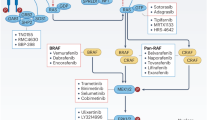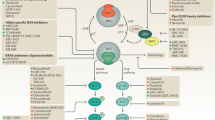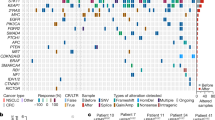Abstract
Activating mutations in B-RAF and N-RAS occur in ∼60 and ∼15% of melanomas, respectively. The most common mutation in B-RAF is V600E, which activates B-RAF and the downstream MEK–ERK1/2 pathway. Thus, B-RAFV600E is a viable therapeutic target. PLX4720 is a selective inhibitor of mutant B-RAF and its analog, PLX4032, is currently undergoing clinical trials in melanoma. However, the effects of PLX4720 across the genotypic spectrum in melanoma remain unclear. Here, we describe that PLX4720 treatment rapidly induces hyperactivation of the MEK–ERK1/2 pathway in mutant N-RAS melanoma cells. Furthermore, we demonstrate that C-RAF is the major RAF isoform involved in this process. Importantly, PLX4720-induced hyperactivation of the MEK–ERK1/2 pathway promotes resistance to apoptosis in both non-invasive and invasive mutant N-RAS melanoma cells but does not enhance cell cycle properties. These findings underscore the need to genotypically stratify melanoma patients before enrollment on a mutant B-RAF inhibitor trial.
This is a preview of subscription content, access via your institution
Access options
Subscribe to this journal
Receive 50 print issues and online access
$259.00 per year
only $5.18 per issue
Buy this article
- Purchase on Springer Link
- Instant access to full article PDF
Prices may be subject to local taxes which are calculated during checkout




Similar content being viewed by others
References
Albino AP, Nanus DM, Mentle IR, Cordon-Cardo C, McNutt NS, Bressler J et al. (1989). Analysis of ras oncogenes in malignant melanoma and precursor lesions: correlation of point mutations with differentiation phenotype. Oncogene 4: 1363–1374.
Boisvert-Adamo K, Aplin AE . (2006). B-RAF and PI-3 kinase signaling protect melanoma cells from anoikis. Oncogene 25: 4848–4856.
Boisvert-Adamo K, Aplin AE . (2008). Mutant B-RAF mediates resistance to anoikis via Bad and Bim. Oncogene 27: 3301–3312.
Boisvert-Adamo K, Longmate W, Abel EV, Aplin AE . (2009). Mcl-1 is required for melanoma resistance to anoikis. Mol Cancer Res 7: 549–556.
Conner SR, Scott G, Aplin AE . (2003). Adhesion-dependent activation of the ERK1/2 cascade is by-passed in melanoma cells. J Biol Chem 278: 34548–34554.
Davies H, Bignell GR, Cox C, Stephens P, Edkins S, Clegg S et al. (2002). Mutations of the BRAF gene in human cancer. Nature 417: 949–954.
Dumaz N, Hayward R, Martin J, Ogilvie L, Hedley D, Curtin JA et al. (2006). In melanoma, RAS mutations are accompanied by switching signaling from BRAF to CRAF and disrupted cyclic AMP signaling. Cancer Res 66: 9483–9491.
Flaherty K, Puzanov I, Sosman J, Kim K, Ribas A, McArthur G et al. (2009). Phase I study of PLX4032: proof of concept for V600E BRAF mutation as a therapeutic target in human cancer. J Clin Oncol 27: Abstract 9000.
Halaban R, Zhang W, Bacchiocchi A, Cheng E, Parisi F, Ariyan S et al. (2010). PLX4032, a selective BRAF V600E kinase inhibitor, activates the ERK pathway and enhances cell migration and proliferation of BRAF WT melanoma cells. Pigment Cell & Melanoma Research 23: 190–200.
Hall-Jackson CA, Eyers PA, Cohen P, Goedert M, Tom Boyle F, Hewitt N et al. (1999). Paradoxical activation of Raf by a novel Raf inhibitor. Chemistry & Biology 6: 559–568.
Hatzivassiliou G, Song K, Yen I, Brandhuber BJ, Anderson DJ, Alvarado R et al. (2010). RAF inhibitors prime wild-type RAF to activate the MAPK pathway and enhance growth. Nature 464: 431–435.
Heidorn SJ, Milagre C, Whittaker S, Nourry A, Niculescu-Duvas I, Dhomen N et al. (2010). Kinase-dead BRAF and oncogenic RAS cooperate to drive tumor progression through CRAF. Cell 140: 209–221.
Hunger-Glaser I, Fan RS, Perez-Salazar E, Rozengurt E. (2004). PDGF and FGF induce focal adhesion kinase (FAK) phosphorylation at Ser-910: dissociation from Tyr-397 phosphorylation and requirement for ERK activation. J Cell Physiol 200: 213–222.
Karasarides M, Chiloeches A, Hayward R, Niculescu-Duvaz D, Scanlon I, Friedlos F et al. (2004). B-RAF is a therapeutic target in melanoma. Oncogene 23: 6292–6298.
King AJ, Patrick DR, Batorsky RS, Ho ML, Do HT, Zhang SY et al. (2006). Demonstration of a genetic therapeutic index for tumors expressing oncogenic BRAF by the kinase inhibitor SB-590885. Cancer Res 66: 11100–11105.
Poulikakos PI, Zhang C, Bollag G, Shokat KM, Rosen N . (2010). RAF inhibitors transactivate RAF dimers and ERK signalling in cells with wild-type BRAF. Nature 464: 427–430.
Pratilas CA, Taylor BS, Ye Q, Viale A, Sander C, Solit DB et al. (2009). V600EBRAF is associated with disabled feedback inhibition of RAF-MEK signaling and elevated transcriptional output of the pathway. Proc Natl Acad Sci USA 106: 4519–4524.
Ritt DA, Monson DM, Specht SI, Morrison DK . (2010). Impact of feedback phosphorylation and Raf heterodimerization on normal and mutant B-Raf signaling. Mol Cell Biol 30: 806–819.
Rushworth LK, Hindley AD, O'Neill E, Kolch W . (2006). Regulation and Role of Raf-1/B-Raf heterodimerization. Mol Cell Biol 26: 2262–2272.
Salerno P, De Falco V, Tamburrino A, Nappi TC, Vecchio G, Schweppe RE et al. (2010). Cytostatic activity of adenosine triphosphate-competitive kinase inhibitors in BRAF mutant thyroid carcinoma cells. J Clin Endocrinol Metab 95: 450–455.
Satyamoorthy K, DeJesus E, Linnenbach AJ, Kraj B, Kornreich DL, Rendle S et al. (1997). Melanoma cell lines from different stages of progression and their biological and molecular analyses. Melanoma Res 7: S35–S42.
Satyamoorthy K, Li G, Gerrero MR, Brose MS, Volpe P, Weber BL et al. (2003). Constitutive mitogen-activated protein kinase activation in melanoma is mediated by both BRAF mutations and autocrine growth factor stimulation. Cancer Res 63: 756–759.
Solit DB, Garraway LA, Pratilas CA, Sawai A, Getz G, Basso A et al. (2006). BRAF mutation predicts sensitivity to MEK inhibition. Nature 439: 358–362.
Sondak VK, Smalley K . (2009). Targeting mutant BRAF and KIT in metastatic melanoma: ASCO 2009 meeting report. Pigment Cell Melanoma Res 22: 386–387.
Tsai J, Lee JT, Wang W, Zhang J, Cho H, Mamo S et al. (2008). Discovery of a selective inhibitor of oncogenic B-Raf kinase with potent antimelanoma activity. Proc Natl Acad Sci USA 105: 3041–3046.
Wan PT, Garnett MJ, Roe SM, Lee S, Niculescu-Duvaz D, Good VM et al. (2004). Mechanism of activation of the RAF-ERK signaling pathway by oncogenic mutations of B-RAF. Cell 116: 855–867.
Acknowledgements
We thank Dr Gideon Bollag (Plexxikon) for providing PLX4720, Dr Meenhard Herlyn (Wistar Institute) for cell lines and Dr Michele Weiss for comments on the manuscript. This work was supported by National Institutes of Health Grants (R01-GM067893 and R01-CA125103), and Pennsylvania Department of Health (AF0301) to AE Aplin.
Author information
Authors and Affiliations
Corresponding author
Ethics declarations
Competing interests
The authors declare no conflict of interest.
Additional information
Supplementary Information accompanies the paper on the Oncogene website
Supplementary information
Rights and permissions
About this article
Cite this article
Kaplan, F., Shao, Y., Mayberry, M. et al. Hyperactivation of MEK–ERK1/2 signaling and resistance to apoptosis induced by the oncogenic B-RAF inhibitor, PLX4720, in mutant N-RAS melanoma cells. Oncogene 30, 366–371 (2011). https://doi.org/10.1038/onc.2010.408
Received:
Revised:
Accepted:
Published:
Issue Date:
DOI: https://doi.org/10.1038/onc.2010.408
Keywords
This article is cited by
-
Optimized scaling of translational factors in oncology: from xenografts to RECIST
Cancer Chemotherapy and Pharmacology (2022)
-
Targeting CDC7 sensitizes resistance melanoma cells to BRAFV600E-specific inhibitor by blocking the CDC7/MCM2-7 pathway
Scientific Reports (2019)
-
Case series of dabrafenib-trametinib-induced pyrexia successfully treated with colchicine
Supportive Care in Cancer (2019)
-
RAF proteins exert both specific and compensatory functions during tumour progression of NRAS-driven melanoma
Nature Communications (2017)
-
Using activation status of signaling pathways as mechanism-based biomarkers to predict drug sensitivity
Scientific Reports (2015)



